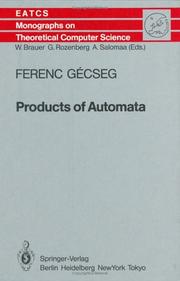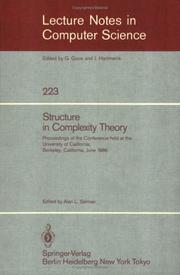| Listing 1 - 10 of 1743 | << page >> |
Sort by
|
Book
ISBN: 1461473209 Year: 2020 Publisher: New York, NY : Springer New York : Imprint: Springer,
Abstract | Keywords | Export | Availability | Bookmark
 Loading...
Loading...Choose an application
- Reference Manager
- EndNote
- RefWorks (Direct export to RefWorks)
The annual Computational Neuroscience Meeting (CNS) began in 1990 as a small workshop called Analysis and Modeling of Neural Systems. The goal of the workshop was to explore the boundary between neuroscience and computation. Riding on the success of several seminal papers, physicists had made "Neural Networks" fashionable, and soon the quantitative methods used in these abstract model networks started permeating the methods and ideas of experimental neuroscientists. Although experimental neurophysiological approaches provided many advances, it became increasingly evident that mathematical and computational techniques would be required to achieve a comprehensive and quantitative understanding of neural system function. “Computational Neuroscience” emerged to complement experimental neurophysiology. In 2002, the non-profit organization, Organization for Computational Neuroscience (OCNS) was formed. OCNS has now become the first professional society serving the global computational neuroscience community. OCNS as a society lives at the interface where experimental neuroscience meets theoretical, statistical and computer-simulation analyses, with the hope of turning large collections of experimental results into a principled understanding of nervous systems. It also supports the development of new engineering, computational and informatics techniques for data collection, analyses and management. The Encyclopedia of Computational Neuroscience will be consultable by both researchers and graduate level students. It will be a dynamic, living reference, continually updatable and containing linkouts and multimedia content whenever relevant.
Neurosciences. --- Neurobiology. --- Computers. --- Computation by Abstract Devices.

ISBN: 354013719X 3642648843 3642616119 9783540137191 Year: 1986 Volume: 7 Publisher: Berlin Springer
Abstract | Keywords | Export | Availability | Bookmark
 Loading...
Loading...Choose an application
- Reference Manager
- EndNote
- RefWorks (Direct export to RefWorks)
Book
ISBN: 0132734265 Year: 1981 Publisher: Englewood Cliffs (N.J.): Prentice Hall international
Abstract | Keywords | Export | Availability | Bookmark
 Loading...
Loading...Choose an application
- Reference Manager
- EndNote
- RefWorks (Direct export to RefWorks)

ISBN: 3540164863 3540398252 Year: 1986 Volume: vol 223 Publisher: Berlin Springer
Abstract | Keywords | Export | Availability | Bookmark
 Loading...
Loading...Choose an application
- Reference Manager
- EndNote
- RefWorks (Direct export to RefWorks)
681.3*F0 --- 681.3*F1 --- Computerwetenschap--?*F0 --- Computation by abstract devices --- 681.3*F1 Computation by abstract devices --- Computer science --- Computer science. --- Computation by Abstract Devices. --- Informatics --- Science
Book
ISBN: 0122850505 9780122850509 Year: 1968 Publisher: New York (N.Y.): Academic press
Abstract | Keywords | Export | Availability | Bookmark
 Loading...
Loading...Choose an application
- Reference Manager
- EndNote
- RefWorks (Direct export to RefWorks)
#TCPW P3.0 --- #TCPW:boek --- 681.3*F1 --- Computation by abstract devices --- Machine theory. --- 681.3*F1 Computation by abstract devices
Book
Year: 2019 Publisher: Cham : Springer International Publishing : Imprint: Springer,
Abstract | Keywords | Export | Availability | Bookmark
 Loading...
Loading...Choose an application
- Reference Manager
- EndNote
- RefWorks (Direct export to RefWorks)
This book is about quantum computing and quantum algorithms. The book starts with a chapter introducing the basic rules of quantum mechanics and how they can be used to build quantum circuits and perform computations. Further, Grover's algorithm is presented for unstructured search discussing its consequences and applications. Next, important techniques are discussed such as Quantum Fourier Transform and quantum phase estimation. Finally, Shor's algorithm for integer factorization is explained. At last, quantum walks are explained in detail covering both the discrete and continuous time models, and applications of this techniques are described for the design and analyses of quantum algorithms.
Computers. --- Quantum computers. --- Quantum physics. --- Computation by Abstract Devices. --- Quantum Computing. --- Quantum Physics.
Book
Year: 2005 Publisher: Berlin ; New York : Springer-Verlag,
Abstract | Keywords | Export | Availability | Bookmark
 Loading...
Loading...Choose an application
- Reference Manager
- EndNote
- RefWorks (Direct export to RefWorks)
Computers. --- Bioinformatics. --- Database management. --- Computation by Abstract Devices. --- Database Management. --- Molecular biology --- Bioinformatics --- Proteomics --- Data processing
Book
Year: 2005 Publisher: Berlin ; New York : Springer-Verlag,
Abstract | Keywords | Export | Availability | Bookmark
 Loading...
Loading...Choose an application
- Reference Manager
- EndNote
- RefWorks (Direct export to RefWorks)
Computers. --- Bioinformatics. --- Database management. --- Computation by Abstract Devices. --- Database Management. --- Molecular biology --- Bioinformatics --- Proteomics --- Data processing
Book
Year: 2019 Publisher: Cham : Springer International Publishing : Imprint: Springer,
Abstract | Keywords | Export | Availability | Bookmark
 Loading...
Loading...Choose an application
- Reference Manager
- EndNote
- RefWorks (Direct export to RefWorks)
This book is about quantum computing and quantum algorithms. The book starts with a chapter introducing the basic rules of quantum mechanics and how they can be used to build quantum circuits and perform computations. Further, Grover's algorithm is presented for unstructured search discussing its consequences and applications. Next, important techniques are discussed such as Quantum Fourier Transform and quantum phase estimation. Finally, Shor's algorithm for integer factorization is explained. At last, quantum walks are explained in detail covering both the discrete and continuous time models, and applications of this techniques are described for the design and analyses of quantum algorithms.
Computers. --- Quantum computers. --- Quantum physics. --- Computation by Abstract Devices. --- Quantum Computing. --- Quantum Physics.
Book
Year: 2019 Publisher: Cham : Springer International Publishing : Imprint: Springer,
Abstract | Keywords | Export | Availability | Bookmark
 Loading...
Loading...Choose an application
- Reference Manager
- EndNote
- RefWorks (Direct export to RefWorks)
This book is about quantum computing and quantum algorithms. The book starts with a chapter introducing the basic rules of quantum mechanics and how they can be used to build quantum circuits and perform computations. Further, Grover's algorithm is presented for unstructured search discussing its consequences and applications. Next, important techniques are discussed such as Quantum Fourier Transform and quantum phase estimation. Finally, Shor's algorithm for integer factorization is explained. At last, quantum walks are explained in detail covering both the discrete and continuous time models, and applications of this techniques are described for the design and analyses of quantum algorithms.
Computers. --- Quantum computers. --- Quantum physics. --- Computation by Abstract Devices. --- Quantum Computing. --- Quantum Physics.
| Listing 1 - 10 of 1743 | << page >> |
Sort by
|

 Search
Search Feedback
Feedback About UniCat
About UniCat  Help
Help News
News